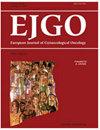宫颈癌手术患者肿瘤大小的评价:超声还是MRI?
IF 0.5
4区 医学
Q4 OBSTETRICS & GYNECOLOGY
引用次数: 0
摘要
目的:比较癌症经阴道超声和MRI测量的肿瘤直径。材料和方法:该研究包括2002年1月至2019年12月在阿克德尼兹大学医学院诊断和治疗的127名癌症患者。使用医院的电子档案系统对数据进行回顾性收集。病理学上未知肿瘤直径的患者被排除在研究之外。对数据进行正态分布检验,平均值、标准差、中值、最小-最大值和频率用作描述性统计。分类数据以数字和百分比(%)表示。Student t检验是一种参数检验,用于比较肿瘤直径。社会科学统计软件包(SPSS)23软件(IBM Corp.,Chicago,IL,USA)用于数据分析。在所有测试中,p值小于0.05被认为具有统计学意义。结果:纳入研究的患者平均年龄为49.55±11.67岁。在所有患者中,79.5%的患者分娩正常。87例(68%)患者未使用任何避孕方法,其中0.7%的患者使用避孕套保护最少。在患者入院时的主诉中,性交后阴道出血是最常见的主诉,占42.5%,无症状患者第二常见,占22%。绝大多数患者(91.3%)的人乳头瘤病毒(HPV)状态未知。就分期状态而言,1b2期是最常见的分期,共有29名患者。肿瘤组织学显示SCC为80.3%,腺癌为18.1%。经阴道超声(TVS)测得的平均肿瘤直径为3.30±1.95,磁共振成像(MRI)测得为3.37±2.03,病理测量的肿瘤直径为3.17±1.86。TVS和MRI、MRI和病理、TVS和病理测量的平均肿瘤直径之间没有统计学上的显著差异(分别为p:0.769、p:0.589、p:0.891)。结论:当妇科肿瘤学领域经验丰富的专家使用时,超声可以被认为与MRI一样有效,尤其是在癌症宫颈癌的肿瘤大小测量中,因为它易于使用、便宜,并且在社会经济地位较低的地区易于获得。本文章由计算机程序翻译,如有差异,请以英文原文为准。
Evaluation of tumor size in cervix cancer patients treated with surgery: ultrasonography or MRI?
Objective : This study aims to compare tumor diameters measured by transvaginal ultrasonography and MRI in cervical cancer. Materials and methods : The study includes 127 cervical cancer patients diagnosed and treated at Akdeniz University Faculty of Medicine between January 2002 and December 2019. Data were collected retrospectively using the electronic archive system of the hospital. Patients with pathologically unknown tumor diameters were excluded from the study. Data were tested for normal distribution, and the mean, standard deviation, median, min-max values, and frequencies were used as descriptive statistics. Categorical data were expressed as numbers and percentages (%). The Student’s t -test, one of the parametric tests, was used to compare tumor diameters. Statistical Package for the Social Sciences (SPSS) 23 software (IBM Corp., Chicago, IL, USA) was used for data analysis. A p -value less than 0.05 was considered statistically significant in all tests. Results : The mean age of patients included in the study was 49.55 ± 11.67 years. Of all patients, 79.5% had a normal delivery. 87 (68%) of the patients were not using any contraceptive method, with 0.7%, condom protection was the least. Among the complaints of patients at admission, postcoital vaginal bleeding was the most common complaint with 42.5%, and asymptomatic patients were the second most common with 22%. Human papillomavirus (HPV) status was unknown in the vast majority of patients (91.3%). Regarding the stage status, stage 1b2 was the most frequently seen stage with 29 patients. Tumor histology revealed SCC in 80.3% and adenocarcinoma in 18.1%. The mean tumor diameter measured by transvaginal ultrasonography (TVS) was 3.30 ± 1.95, by magnetic resonance imaging (MRI) was 3.37 ± 2.03, and the pathologically measured tumor diameter was 3.17 ± 1.86. There was no statistically significant difference between the mean tumor diameter measured by TVS and MRI, MRI and pathology, and TVS and pathology ( p : 0.769, p : 0.589, p : 0.891, respectively). Conclusion : When used by specialists experienced in the field of gynecological oncology, ultrasonography can be considered as effective as MRI, especially in tumor size measurement in cervical cancer, due to its ease of use, cheapness, and easy accessibility in regions with low socioeconomic status.
求助全文
通过发布文献求助,成功后即可免费获取论文全文。
去求助
来源期刊
自引率
25.00%
发文量
58
审稿时长
1 months
期刊介绍:
EJGO is dedicated to publishing editorial articles in the Distinguished Expert Series and original research papers, case reports, letters to the Editor, book reviews, and newsletters. The Journal was founded in 1980 the second gynaecologic oncology hyperspecialization Journal in the world. Its aim is the diffusion of scientific, clinical and practical progress, and knowledge in female neoplastic diseases in an interdisciplinary approach among gynaecologists, oncologists, radiotherapists, surgeons, chemotherapists, pathologists, epidemiologists, and so on.

 求助内容:
求助内容: 应助结果提醒方式:
应助结果提醒方式:


